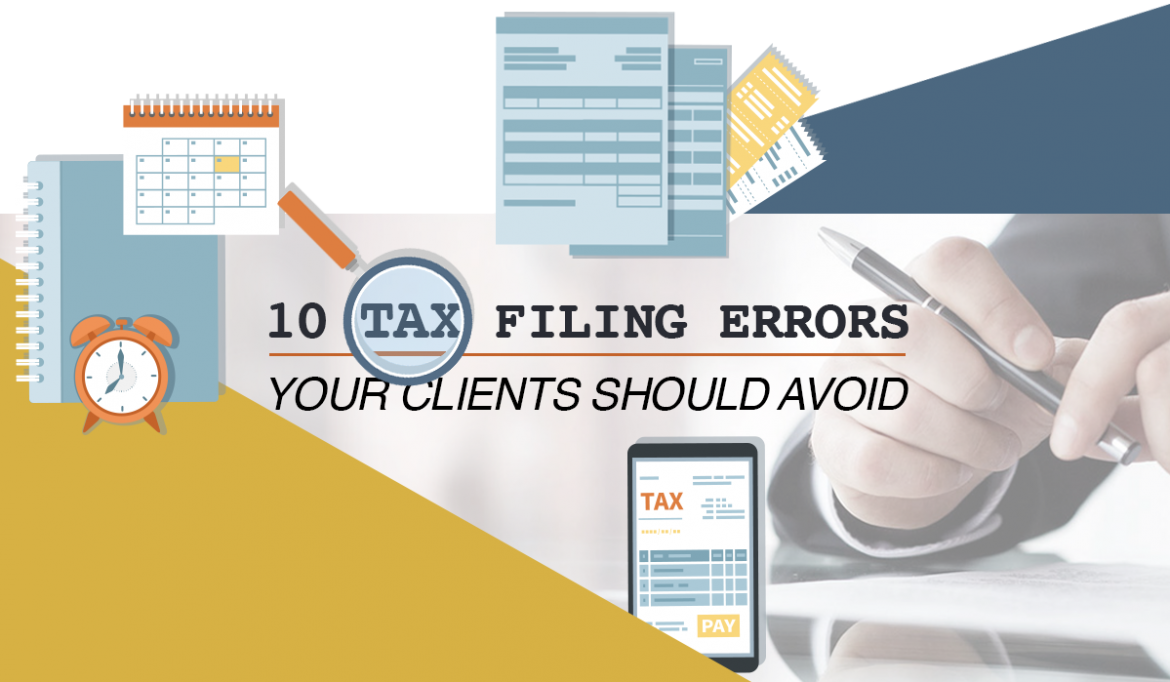Tax season began on January 27 and the April 15 filing deadline always seem to sneak up on us. And with each passing tax season, there are always tax filing errors your clients can avoid. As a financial professional, you’re entrusted with managing their assets in all areas, including tax planning and tax return preparation.
To ensure that your clients’ tax filing season goes smoothly, highlighted here are some of the common tax filing errors published by the IRS. Many of which can be prevented with a little extra attention or from the help of their financial team.
It’s in your clients’ benefit to catch errors before filing because a simple oversight could delay or cost them a refund if they’re entitled to one. A blunder that causes clients to underpay their taxes could lead to stern letters and penalties from the IRS or, worse, trigger an audit. Here are tips and reminders you can share with your clients to help them avoid making common tax filing errors.
Common Tax Filing Errors to Avoid
1. File electronically. By filing electronically, the e-filing system can catch many common mistakes to save clients from delays in processing their returns.
2. Review deductions. The IRS says many mistakes happen when taxpayers are calculating their deductions. For example, if your clients are age 65 or older or if they’re blind, are they aware that they’re eligible for a $1,650 additional standard deduction?
3. Choose only one correct filing status. Choosing the right filing status makes all the difference in making sure your clients get the maximum refund along with all the credits and deductions they’re entitled to.

4. Choose the right number of dependents. While this should be a simple decision, it becomes complicated during life’s transitions. For example, did their child recently get a full-time job? Or did your client recently become responsible for an elder’s care? If so, they may want to review whether they can claim them as dependents or not.
5. Correct the spelling of names and Social Security numbers. Make sure that all names and Social Security numbers match what’s on your clients’ (and their spouse’s) Social Security cards.
If they’ve changed their name since the last time they filed their taxes, they’ll need to notify the Social Security Administration (SSA) to have their information updated. This can be done by filing a Form SS-5 at a local SSA office or by mail.
Related: Guide to Maximizing Your Social Security Benefits [Client Guide]
6. Report any additional income. Aside from the income they’re receiving from their investments, are you aware of any other additional income that your clients made this year, such as a side job that they may have picked up? Forgetting to disclose all sources of income on their return could leave them owing additional taxes and penalties on their unreported earnings.
7. Sign the return and attach all documents. The IRS won’t accept unsigned tax returns, so it’s critical that your clients (and their spouses if filing jointly) sign their tax return and include all necessary schedules and documents (don’t forget to remind them to make copies for their own record). And if they owe taxes, be sure that they enclose a check or money order made payable to “United States Treasury” and include their name, address, taxpayer identification number, contact number, tax form, and tax year on the payment.
8. Double-check direct deposit information. Most taxpayers give the IRS bank account information to receive their refund by direct deposit. Unfortunately, if your clients give the IRS the wrong account information, their refund results in delays or even penalties and interest on late payments. It doesn’t hurt to double-check!

Related: Tax Breaks for Charitable Giving Have Disappeared – How Can You Help?
9. Don’t wait last minute. Procrastination is nothing new when it comes to filing taxes. Quality tax planning requires an ample amount of timing and preparation. Waiting until the last minute generally means preparing taxes without adequate information and analysis. To properly assist your clients in navigating their taxes, advise them to commit themselves to more frequent engagements ahead of the deadline.
10. Not consulting with you and your team. Tax laws are complex and consumer-grade tax preparation software is only designed to meet the needs of the average taxpayer. Have you reached out to your clients recently to offer tax advice? With your guidance, you can help prevent mistakes and identify potential tax savings.
Final Thoughts on Tax Filing
The tax filing season presents a great opportunity for adding value to your client relationships. Not only is it a chance to reconnect with your clients to help with tax preparation, but it also allows you to review your clients’ financials over the past year and identify planning opportunities for the years ahead.
In what ways are you helping your clients get the most out of this tax season?
Keep Reading: Use Fixed Indexed Annuities to Pay for Long-Term Care With This Tax-Efficient Strategy
Disclosure: The content within this document is for informational and educational purposes only and does not constitute legal or tax advice. Customers should consult a legal or tax professional regarding their own situation. This document is not an offer to purchase, sell, replace, or exchange any product. The firm providing this document is not affiliated with the Social Security Administration or any other government entity.

